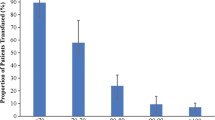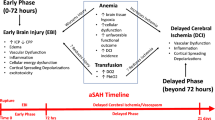Abstract
Background
Elevated red blood cell distribution width (RDW) has been associated with thrombotic disorders including myocardial infarction, venous thromboembolism, and ischemic stroke, independent of other inflammatory and coagulation biomarkers. The purpose of this study was to determine whether elevated RDW is associated with cerebral infarction and poor outcome after aneurysmal subarachnoid hemorrhage (aSAH).
Methods
In this retrospective single-center cohort of aSAH patients (October 2009–September 2014), elevated RDW was defined as a mean RDW >14.5 % during the first 14 days after aSAH. Outcomes included cerebral infarction (CI) by any mechanism and poor functional outcome, defined as discharge modified Rankin Scale (mRS) >4, indicating severe disability or death.
Results
Of 179 patients, 27 % had a high Hunt–Hess grade (IV–V), and 76 % were women. Twenty-four patients (13.4 %) underwent red blood cell (RBC) transfusion and compared to patients with normal RDW, patients with an elevated RDW were at greater odds of RBC transfusion (OR 2.56 [95 % CI, 1.07–6.11], p = 0.035). In univariate analysis, more patients with elevated RDW experienced CI (30.8 vs. 13.7 %, p = 0.017). In the multivariable model, elevated RDW was significantly associated with CI (OR 3.08 [95 % CI, 1.30–7.32], p = 0.011), independent of known confounders including but not limited to age, sex, race, high Hunt–Hess grade, and RBC transfusion. In multivariable analysis, RDW elevation was also associated with poor functional outcome (mRS > 4) at discharge (OR 2.59 [95 % CI, 1.04–629], p = 0.040).
Conclusions
RDW elevation is associated with cerebral infarction and poor outcome after aSAH. Further evaluation of this association is warranted as it may shed light on mechanistic relations between anemia, inflammation, and thrombosis after aSAH.


Similar content being viewed by others
References
Nieuwkamp DJ, Setz LE, Algra A, Linn FH, de Rooij NK, Rinkel GJ. Changes in case fatality of aneurysmal subarachnoid haemorrhage over time, according to age, sex, and region: a meta-analysis. Lancet Neurol. 2009;8:635–42.
Hijdra A, Van Gijn J, Stefanko S, Van Dongen KJ, Vermeulen M, Van Crevel H. Delayed cerebral ischemia after aneurysmal subarachnoid hemorrhage: clinicoanatomic correlations. Neurology. 1986;36:329–33.
Rabinstein AA, Weigand S, Atkinson JL, Wijdicks EF. Patterns of cerebral infarction in aneurysmal subarachnoid hemorrhage. Stroke J Cereb Circ. 2005;36:992–7.
Vergouwen MD, Ilodigwe D, Macdonald RL. Cerebral infarction after subarachnoid hemorrhage contributes to poor outcome by vasospasm-dependent and -independent effects. Stroke J Cereb Circ. 2011;42:924–9.
Vergouwen MD, Vermeulen M, Coert BA, Stroes ES, Roos YB. Microthrombosis after aneurysmal subarachnoid hemorrhage: an additional explanation for delayed cerebral ischemia. J Cereb Blood Flow Metab. 2008;28:1761–70.
Maiuri F, Gallicchio B, Donati P, Carandente M. The blood leukocyte count and its prognostic significance in subarachnoid hemorrhage. J Neurosurg Sci. 1987;31:45–8.
Sadamasa N, Yoshida K, Narumi O, Chin M, Yamagata S. Prediction of mortality by hematological parameters on admission in patients with subarachnoid hemorrhage. Neurol Med Chir. 2011;51:745–8.
Juvela S, Siironen J. D-dimer as an independent predictor for poor outcome after aneurysmal subarachnoid hemorrhage. Stroke J Cereb Circ. 2006;37:1451–6.
Meynaar IA, Knook AH, Coolen S, Le H, Bos MM, van der Dijs F, et al. Red cell distribution width as predictor for mortality in critically ill patients. Neth J Med. 2013;71:488–93.
Ellingsen TS, Lappegard J, Skjelbakken T, Braekkan SK, Hansen JB. Red cell distribution width is associated with incident venous thromboembolism (vte) and case-fatality after vte in a general population. Thromb Haemost. 2015;113:193–200.
Zoller B, Melander O, Svensson P, Engstrom G. Red cell distribution width and risk for venous thromboembolism: a population-based cohort study. Thromb Res. 2014;133:334–9.
Tonelli M, Sacks F, Arnold M, Moye L, Davis B, Pfeffer M, et al. Relation between red blood cell distribution width and cardiovascular event rate in people with coronary disease. Circulation. 2008;117:163–8.
Ramirez-Moreno JM, Gonzalez-Gomez M, Ollero-Ortiz A, Roa-Montero AM, Gomez-Baquero MJ, Constantino-Silva AB. Relation between red blood cell distribution width and ischemic stroke: a case-control study. Int J Stroke. 2013;8:E36.
Saliba W, Barnett-Griness O, Elias M, Rennert G. The association between red cell distribution width and stroke in patients with atrial fibrillation. Am J Med. 2015;128:192.e11–8.
Chugh C, Nyirjesy SC, Nawalinski KP, Sandsmark DK, Frangos S, Maloney-Wilensky E, et al. Red blood cell distribution width is associated with poor clinical outcome after subarachnoid hemorrhage: a pilot study. Neurocrit Care. 2015;23:217–24.
Hunt WE, Hess RM. Surgical risk as related to time of intervention in the repair of intracranial aneurysms. J Neurosurg. 1968;28:14–20.
Fisher CM, Kistler JP, Davis JM. Relation of cerebral vasospasm to subarachnoid hemorrhage visualized by computerized tomographic scanning. Neurosurgery. 1980;6:1–9.
Connolly ES Jr, Rabinstein AA, Carhuapoma JR, Derdeyn CP, Dion J, Higashida RT, et al. Guidelines for the management of aneurysmal subarachnoid hemorrhage: a guideline for healthcare professionals from the American heart association/American stroke association. Stroke J Cereb Circ. 2012;43:1711–37.
Diringer MN, Bleck TP, Claude Hemphill J 3rd, Menon D, Shutter L, Vespa P, et al. Critical care management of patients following aneurysmal subarachnoid hemorrhage: recommendations from the neurocritical care society’s multidisciplinary consensus conference. Neurocritical Care. 2011;15:211–40.
Vergouwen MD, Vermeulen M, van Gijn J, Rinkel GJ, Wijdicks EF, Muizelaar JP, et al. Definition of delayed cerebral ischemia after aneurysmal subarachnoid hemorrhage as an outcome event in clinical trials and observational studies: proposal of a multidisciplinary research group. Stroke J Cereb Circ. 2010;41:2391–5.
Ani C, Ovbiagele B. Elevated red blood cell distribution width predicts mortality in persons with known stroke. J Neurol Sci. 2009;277:103–8.
Larsen CC, Hansen-Schwartz J, Nielsen JD, Astrup J. Blood coagulation and fibrinolysis after experimental subarachnoid hemorrhage. Acta Neurochir (Wien). 2010;152:1577–81 discussion 1581.
Boluijt J, Meijers JC, Rinkel GJ, Vergouwen MD. Hemostasis and fibrinolysis in delayed cerebral ischemia after aneurysmal subarachnoid hemorrhage: a systematic review. J Cereb Blood Flow Metab. 2015;35:724–33.
Furie B, Furie BC. Mechanisms of thrombus formation. New Engl J Med. 2008;359:938–49.
Kolias AG, Sen J, Belli A. Pathogenesis of cerebral vasospasm following aneurysmal subarachnoid hemorrhage: putative mechanisms and novel approaches. J Neurosci Res. 2009;87:1–11.
Janjua N, Mayer SA. Cerebral vasospasm after subarachnoid hemorrhage. Curr Opin Crit Care. 2003;9:113–9.
Zorlu A, Bektasoglu G, Guven FM, Dogan OT, Gucuk E, Ege MR, et al. Usefulness of admission red cell distribution width as a predictor of early mortality in patients with acute pulmonary embolism. Am J Cardiol. 2012;109:128–34.
Azab B, Torbey E, Hatoum H, Singh J, Khoueiry G, Bachir R, et al. Usefulness of red cell distribution width in predicting all-cause long-term mortality after non-st-elevation myocardial infarction. Cardiology. 2011;119:72–80.
Tsuboi S, Miyauchi K, Kasai T, Ogita M, Dohi T, Miyazaki T, et al. Impact of red blood cell distribution width on long-term mortality in diabetic patients after percutaneous coronary intervention. Circ J. 2013;77:456–61.
Uyarel H, Ergelen M, Cicek G, Kaya MG, Ayhan E, Turkkan C, et al. Red cell distribution width as a novel prognostic marker in patients undergoing primary angioplasty for acute myocardial infarction. Coron Artery Dis. 2011;22:138–44.
Dabbah S, Hammerman H, Markiewicz W, Aronson D. Relation between red cell distribution width and clinical outcomes after acute myocardial infarction. Am J Cardiol. 2010;105:312–7.
Kim J, Kim YD, Song TJ, Park JH, Lee HS, Nam CM, et al. Red blood cell distribution width is associated with poor clinical outcome in acute cerebral infarction. Thromb Haemost. 2012;108:349–56.
Forhecz Z, Gombos T, Borgulya G, Pozsonyi Z, Prohaszka Z, Janoskuti L. Red cell distribution width in heart failure: prediction of clinical events and relationship with markers of ineffective erythropoiesis, inflammation, renal function, and nutritional state. Am Heart J. 2009;158:659–66.
Lippi G, Targher G, Montagnana M, Salvagno GL, Zoppini G, Guidi GC. Relation between red blood cell distribution width and inflammatory biomarkers in a large cohort of unselected outpatients. Arch Pathol Lab Med. 2009;133:628–32.
Rhodes CJ, Wharton J, Howard LS, Gibbs JS, Wilkins MR. Red cell distribution width outperforms other potential circulating biomarkers in predicting survival in idiopathic pulmonary arterial hypertension. Heart. 2011;97:1054–60.
Montagnana M, Cervellin G, Meschi T, Lippi G. The role of red blood cell distribution width in cardiovascular and thrombotic disorders. Clin Chem Lab Med. 2012;50:635–41.
Funding and Support
The authors report no competing financial interests exist.
Author information
Authors and Affiliations
Corresponding author
Electronic supplementary material
Below is the link to the electronic supplementary material.
Rights and permissions
About this article
Cite this article
Siegler, J.E., Marcaccio, C., Nawalinski, K. et al. Elevated Red Cell Distribution Width is Associated with Cerebral Infarction in Aneurysmal Subarachnoid Hemorrhage. Neurocrit Care 26, 26–33 (2017). https://doi.org/10.1007/s12028-016-0306-2
Published:
Issue Date:
DOI: https://doi.org/10.1007/s12028-016-0306-2




